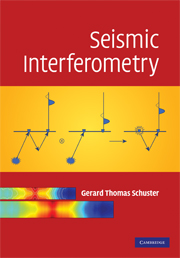Book contents
- Frontmatter
- Contents
- Preface
- 1 Introduction
- 2 Reciprocity equations of convolution and correlation types
- 3 VSP → SWP correlation transform
- 4 VSP → SSP correlation transform
- 5 VSP → SSP convolution transform
- 6 SSP → SSP correlation transform
- 7 VSP → VSP correlation transform
- 8 SSP → VSP → SWP transforms
- 9 Traveltime interferometry
- 10 Stochastic interferometry
- 11 Interferometric source estimation
- 12 Body wave earthquake interferometry
- References
- Index
2 - Reciprocity equations of convolution and correlation types
Published online by Cambridge University Press: 15 October 2009
- Frontmatter
- Contents
- Preface
- 1 Introduction
- 2 Reciprocity equations of convolution and correlation types
- 3 VSP → SWP correlation transform
- 4 VSP → SSP correlation transform
- 5 VSP → SSP convolution transform
- 6 SSP → SSP correlation transform
- 7 VSP → VSP correlation transform
- 8 SSP → VSP → SWP transforms
- 9 Traveltime interferometry
- 10 Stochastic interferometry
- 11 Interferometric source estimation
- 12 Body wave earthquake interferometry
- References
- Index
Summary
This chapter presents the governing equation of acoustic interferometry, also known as the reciprocity equation of the correlation type (Bojarski, 1983; de Hoop, 1995; Wapenaar, 2004; Wapenaar and Fokkema, 2006). It is an integral equation based on Green's theorem, except the integrand is a product of both acausal and causal Green's functions. The far-field approximation to this reciprocity equation reduces to the equations (Wapenaar, 2004; Wapenaar and Fokkema, 2006; Schuster and Zhou, 2006) used for daylight imaging (Rickett and Claerbout, 1999), reverse time acoustics (Lobkis and Weaver, 2001), the virtual source method (Calvert et al., 2004), and seismic interferometric imaging (Schuster et al., 2004). In contrast, the reciprocity equation of the convolution type is an integral equation where the kernels are products of causal Green's functions.
Variants of the correlation-reciprocity equation were in widespread use by the seismic exploration community prior to 1983, and went under the designations of Kirchhoff migration (Schneider, 1978) and Kirchhoff datuming (Berryhill, 1979, 1984). These methods differ from seismic interferometry in that the acausal Green's functions (or wavefield extrapolators) used by the migration community are computed with a forward modeling code and an assumed velocity model. In contrast, the interferometry community obtains these Green's functions directly from the data.
The convolution-reciprocity and correlation-reciprocity equations will be first derived using Green's theorem, and the stationary phase method is then used to interpret its physical meaning. The last section presents the derivation of the formula for interferometric imaging.
Green's functions
The acoustic Green's function in 3D is the impulsive point source response of an acoustic medium.
- Type
- Chapter
- Information
- Seismic Interferometry , pp. 30 - 60Publisher: Cambridge University PressPrint publication year: 2009
- 1
- Cited by



